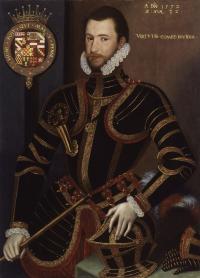
I wanted to research what the Province of Ulster was like just before the Plantation. This would give me an insight into the population density, economic activity and politics of the region the Scots-Irish were about to enter. I came across this wonderful article published around 8 years ago in History Ireland Magazine.
One of Ireland’s most important parliaments was held in Dublin in 1541. This declared Henry VIII to be ‘king of Ireland’ and made all Irishmen, whatever their origin, Gaelic or Norman, his subjects with equal rights under common law. It enacted the ‘surrender and regrant’ legislation and, while English was the official language, much of the proceedings was translated into Irish for the benefit of the many attendees who knew no English. Among them was the lord of Clandeboye, whose name we do not know. It is not unreasonable, however, to assume that this was Brian Faghartach, eldest son of Niall Óg (d. 1537), and he may also have participated in ‘surrender and regrant’ agreements in the early 1540s. Whether he did or not, in 1548 he was assassinated by Shane O’Neill, then a twenty-year-old about to make a name for himself in Ulster.
Shane O’Neill
Over the next nineteen years Shane established himself as a supremo in Ulster and controlled Clandeboye as one of his urriaght (subsidiary) territories. This was not simple, as he had to cope with the Scots, incursions into his territory by forces from Dublin and the English garrison at Carrickfergus, which appears to have been completely re-Anglicised by the mid-1560s when controlled by William Piers. Piers established relationships with Owen McHugh in south Clandeboye and Brian McPhelim in north Clandeboye, both getting large sums for cooperation. It is likely that both became inter alia ‘intelligence agents’ on Piers’s behalf and perhaps had a role in the ultimate destruction of Shane O’Neill, both at Farsetmore (see HI 19.3, May/June 2011, pp 16–21), where Shane’s defeat cost him some 2,000 men, and ultimately at the hands of the McDonnells, who hacked him to death in 1567. Shane had become a major liability to the governments in both London and Dublin and Sir Henry Sidney, the lord deputy, took all necessary measures to get rid of him. During the fifteen-month period up to September 1567 Piers was paid £3,589 and Owen McHugh and Brian McPhelim £626, huge sums disbursed by the Dublin treasury. Brian McPhelim O’Neill was knighted, presumably for his role in helping to get rid of Shane, but a further consequence of the campaign was the destruction of the agricultural economy around Carrickfergus. According to Rowland White of Lecale, Co. Down, an Old English correspondent with the government, writing in 1569, before the English garrisoning of Carrickfergus (in the 1560s) there were 500 or 600 ploughlands under grain within ten miles of the town, but afterwards only five or six. This destruction was wrought by the soldiers of Carrickfergus. The results of the war against Shane were confirmed by the Dublin parliament of 1570, where he was attainted, his lands confiscated to the Crown and east Ulster divided into the shires of Antrim and Down. While Sir Brian McPhelim was still regarded as chief of Clandeboye, neither he nor any other Clandeboye got a title to their lands. This parliament also marked the de facto end of the medieval earldom of Ulster.
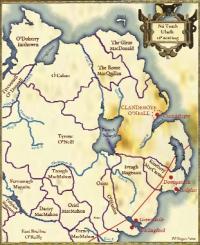 Failed colonisation schemes
Failed colonisation schemes
While east Ulster was now pacified, the English in London attempted to benefit from it. Queen Elizabeth therefore approved colonisation plans for both north Down and the Ards on the one hand and all south Antrim on the other. Sir Thomas Smith, her former secretary of state, was awarded north Down and the Ards, while the earl of Essex was awarded the whole of County Antrim except for the Route and the Glynns (Glens), i.e the southern half of County Antrim. From the queen’s point of view, the most salient feature of both of these plans was that they were to be completely financed by the promoters and were ultimately to yield her an income for no investment on her part. These grants were made over the head of the lord deputy, Sidney. Both colonisation attempts failed through incompetence of different sorts. Sir Thomas Smith, underestimating what was involved, advertised in London for colonists to participate in his venture. When Sir Brian McPhelim O’Neill of Clandeboye heard of this, that—despite his fulsome cooperation in the war against Shane—his land was now to be taken from him and given to Smith, he immediately set about destroying any infrastructure that might be used by Smith to garrison troops. He therefore destroyed all the monastic buildings in north Down and the Ards, including those at Newtown (Ards), Bangor, Movilla, Comber and Grey Abbey. It is not clear whether this involved displacement of tenantry. These churls (labourers) were thought by the English to be cooperative, hard-working and productive if only they could rid themselves of their over-exploitative Gaelic landlords. The main promoter of the colony on the ground was Sir Thomas Smith’s son. The venture came to an end in 1573 when he was killed by one of his Irish servants, his body boiled and fed to dogs.
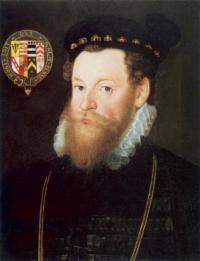
In the case of Essex, the earl appears to have been inveigled into the venture by those at court who wanted rid of him. He invested a large fortune, mortgaging thirteen of his English manors and getting a loan of £10,000 at 10% interest from the queen. His was a very bloody venture. During his time in Ireland many Scots were killed, the notorious massacre at Rathlin Island was perpetrated by Norris and Drake, and he destroyed much of north Clandeboye. According to himself, in a letter to the queen in July 1575, he ‘left all the county desolate and without people’. Neil McBrian’s ‘people [he had succeeded Sir Brian McPhelim] were few, his cattle less [and] his husbandmen were starved, dead or run out of the country’. Perhaps Essex’s worst atrocity occurred at the Christmas feast at Belfast in 1574 given by Sir Brian McPhelim, when Essex—according to himself, suspecting treachery—had all 200 participants, of whatever age or sex, killed. The Four Masters claim that this massacre was gratuitous murder without cause. Sir Brian himself, his wife and his brother Rory Óg were arrested, brought to Dublin and executed. Essex achieved nothing by his exploits in Antrim. In 1576 he fell ill of dysentery in Dublin, where he died. Sidney visited Ulster later that year. He claimed that Carrickfergus was much decayed and impoverished, the inhabitants fled, not about six householders of any countenance remaining, and Clandeboye was ‘utterly disinhabited’. Such were the results of the first attempts to colonise the new counties of Antrim and Down. The main English participants incurred great loss of money and some loss of life.
War amongst the Gaelic Irish
A period of relative peace followed in Clandeboye between the Irish and the English. This was not the case among the Irish themselves. In promoting Neill McBrian Ertagh, Essex ignored the claims of other contenders for the lordship. These included Sir Brian McPhelim’s son and brother as well as Con McNeill, Niall McBrian Ertagh’s uncle. A tentative division of the lordship was made in 1584 under the auspices of Lord Deputy Perrott. Con was to have south Clandeboye, while the north was to be divided between Shane, son of Sir Brian McPhelim, and Hugh Oge, son of his brother, also Hugh. This arrangement led to the killing of Hugh Oge in 1586. North Clandeboye was bitterly disputed between the sons of the brothers Sir Brian and Hugh McPhelim, causing ‘great dissension between them, and great slaughter often by both parties committed’. Eventually Shane was allotted the castle at Belfast and three parts of lower Clandeboye and followers, while Neill was allotted one quarter of the territory and followers and the castle at Edenduffcarrick on the shores of Lough Neagh. Henceforth Clandeboye would be held by the descendants of these two men. All these settlements were authorised by the English.These arrangements might have held if the English had been able to protect and defend them against the ambitions of Hugh O’Neill, earl of Tyrone. Because they couldn’t, O’Neill was able to establish his supremacy and during the Nine Years War sent his nephew, Brian MacArt, to organise and control Clandeboye military contingents to fight on his side. These were relatively small, perhaps because the Clandeboye population had not fully recovered from the devastation unleashed by Essex and Smith’s attemped plantations. No great battles were fought in Antrim and Down during this war. The war there consisted of small local engagements, none of which was decisive. To the English Clandeboye was more of a nuisance than a threat. This was to change once Sir Arthur Chichester was appointed governor of Carrickfergus. He determined to finish Clandeboye. He quickly overran north Clandeboye and got some of its Irish lords on the English side.
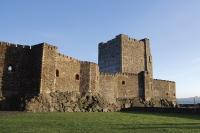
Famine and massacre as tactics of war
Chichester believed in famine as the main method of defeating the Gaelic Irish. Mountjoy agreed, and after the victory at Kinsale in 1601 both set about burning and killing in Ulster, destroying crops and animals as well as men, women and children without scruple. While Chichester is infamous for his trips across Lough Neagh, burning and killing, he confined most of his activities to Antrim and Down. This succeeded in destroying Clandeboye as a safe haven and a supply base for Tyrone. Apart from winning the war, Chichester had another and more personal motivation. Managing his estate and inheritances in Devon had left him virtually bankrupt and he saw the prospect of land confiscated in Ireland after the war as a means of restoring his fortunes. He coveted the lands of Clandeboye. To acquire these he took the Carrickfergus governorship with a hand-picked staff of English officers from backgrounds and circumstances similar to his own, second sons with limited if any prospects in England but who could make fortunes from land confiscated in Ulster.Chichester and his cohorts set about their task with a determined, ruthless mercilessness. Letters written by Chichester himself, confirmed by the accounts of Fynes Morrison, Mountjoy’s secretary, show what unremitting devastation was inflicted without compunction for age or sex. The standard histories of the period tell of cannibalism, corpses green-mouthed from eating grass, and dead bodies piled by the roadsides. There was so much killing of churls that even Mountjoy found the excesses distasteful. Chichester left lower Clandeboye, i.e. the southern half of modern County Antrim, utterly devastated and depopulated. North Down was not destroyed to the same extent. When its lord, Con O’Neill, saw that Tyrone’s cause was lost, he immediately surrendered to the queen and was confirmed in his lands as an encouragement to others to do likewise. He returned to Castlereagh to find most of his lands, though not all, devastated like those of Antrim but was able to save what remained of his tenantry from further burning and slaughter by Chichester’s flying columns.
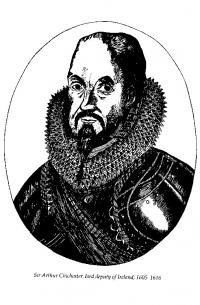
Dividing the spoils
Once the war was over it was time to divide the spoils. Inquisitions were held in 1605 in Antrim and Down to assess exactly what was available for distribution among the victors. The Antrim inquisition found, according to Belfast antiquarian F.J. Bigger:
‘… in lower Clanaboy [sic] there were twenty-one sub-territories containing vast tracts of the finest lands in Ulster, and inhabited by a very numerous population, but Chichester left it desolate’.
These lands were distributed among Chichester and his followers, although the remaining few loyal Gaelic nobles got generous estates. The story of Con O’Neill and how he lost two thirds of his estates to Hamilton and Montgomery in upper Clandeboye (north Down) is well known. These latter expelled their remaining Gaelic tenants to the Dufferin barony.Scottish immigrants began arriving at Donaghadee from May 1606 to take up new tenancies first in Down and later in Antrim. They found no resistance. There was nobody left to offer it. By now James VI of Scotland had become James I of England. Thus started the peopling of these parts with inhabitants who then and subsequently were to be described as ‘British’. HI
Tom Murphy is a retired internal auditor. Article based on his MA thesis, ‘Clandeboye: its rise and decline c. 1350–1606’.